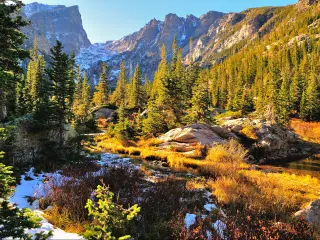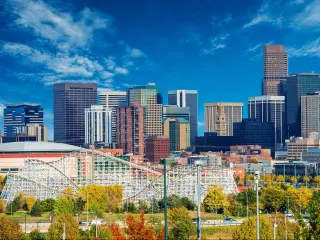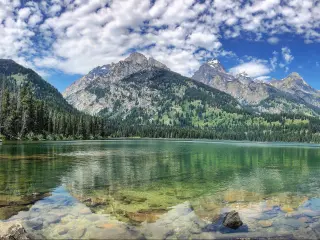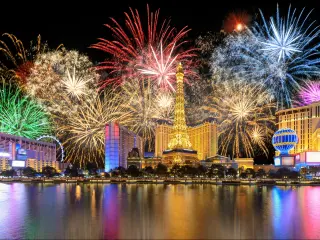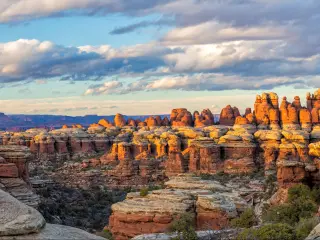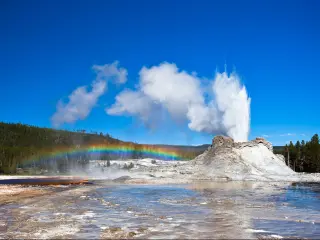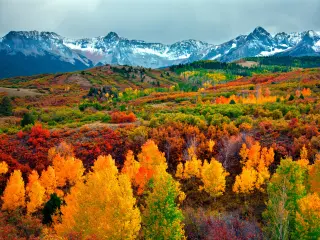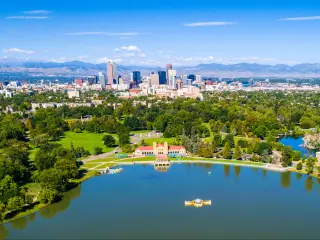Can you Drive through Rocky Mountain National Park?
Located in northern Colorado, in the western United States, Rocky Mountain National Park is the 6th highest national park in the USA. With parts of the park soaring up to 14,259 feet above sea level, visitors can enjoy mountain views which are reachable by scenic hiking trails.
It is possible to drive through Rocky Mountain National Park. The 43-mile drive from Beaver Meadows Entrance to Grand Lake takes 1 hour 20 minutes. This scenic route closes in winter but you can still drive through other sections of the park.
Encompassing 416 square miles of alpine mountains, flowing rivers, pristine lakes and an abundance of wildlife to spot. As a popular nature spot, Rocky Mountain National Park greets around 3 million visitors per year. You can also snowshoe, sled or cross-country ski here in winter, when the park usually sits under deep snow.
Can you drive through Rocky Mountain National Park?
Rocky Mountain National Park is located in northern Colorado. It's sandwiched between two towns, Grand Lake to the west and Estes Park to the east. The nearest major city is Boulder which is 40 miles south of the Beaver Meadows Entrance. Fort Collins is also 45 miles northeast of the Beaver Meadows entrance.
In the summer months you can drive through Rocky Mountain National Park via a number of popular scenic routes. Driving through the national park along Trail Ridge Road for the full 43 miles is the ultimate scenic drive, but as we've mentioned, this route closes in the winter.
In winter, you have a few alternative options, ranging from 2 miles to 10 miles. The most comprehensive is the 10-mile Bear Lake Road route. Note that the winter routes can also be accessed in summer. They're shorter, so these routes are also suitable if you're short on time, whatever time of the year.
The four entrances to the national park at Beaver Meadows, Fall River, Wild Basin and Grand Lake are open year-round. However, onward road access is restricted in winter due to the weather.
Note: Please note that due to a major construction project that has just begun, the Fall River Entrance only has one lane is open to enter. Visitors are encouraged to avoid this entrance and use the Beaver Meadows Entrance via US-36.
There can be wait times at both major east-side entrances to the national park. Please check whether this route is still closed before you travel.
Check out the table below to get an idea of the main routes through the park, and when you can drive them.
| Seasonal Route | Starting Point | Ending Point | Availability |
|---|---|---|---|
| Summer Route | Beaver Meadows Entrance | Grand Lake | Late May to early October |
| Winter Route A | Beaver Meadows Entrance | Upper Beaver Meadows Trailhead | All year round |
| Winter Route B | Wild Basin Lodge | Wild Basin Trailhead | All year round |
| Winter Route C | Beaver Meadows Entrance | Fern Lake Trailhead | All year round |
| Winter Route D | Beaver Meadows Entrance | Bear Lake Trailhead | All year round |
If you don't want to drive through Rocky Mountain National Park yourself, there's also the option of taking the free shuttle bus. The shuttle is a good method to avoid busy parking lots and takes you to notable hiking spots. However, it only operates between late May and early October.
Keep on reading to find out more about the main routes through the park along with their seasonal opening and how long it will take you to drive them.
How to drive through Rocky Mountain National Park on the Summer Route
Our Summer Route takes you along Trail Ridge Road, which is considered one of America's best scenic drives. It's a great way to see the park with overlooks and trailheads along the route.

It's a pretty straightforward route to navigate. However, if you're afraid of heights we recommend avoiding this road as there are some stretches where the road is close to the cliff edge. This is a two-lane highway however there are many pull-offs, so if someone behind wants to go faster, pull over and let them pass.
From Estes Park, follow US-36 to RMNP Beaver Meadows Entrance where you'll pass through the toll station into the national park. Then, right by Deer Mountain Trailhead, merge onto US-34.
Some tight switchbacks then take you past Hidden Valley Parking Area, Many Parks Curve Overlook and Rainbow Curve Overlook. You're high up in the mountains by this point, out of the forested part of the national park, and stops including Forest Canyon Overlook offer amazing views out across the mountains.
After passing the Trail Ridge Road Summit, the road begins to travel slowly downhill through Medicine Bow Curve and across the Continental Divide.You might want to take a break at Farview Curve Viewpoint, before a series of tight switchbacks take you on toward the Colorado River. The road then runs parallel to the river most of the way into Grand Lake.
How to drive through Rocky Mountain National Park on the Winter Route
There are a number of routes you can drive in Rocky Mountain National Park during the winter. None of them takes you anywhere near as far as the Summer Route, but you'll still be in for some fabulous seasonal views.
From Beaver Meadows Entrance, follow the road a short distance before taking the signposted left turn onto Upper Beaver Meadows Road. This 2-mile route takes you out to Upper Beaver Meadows Trailhead.
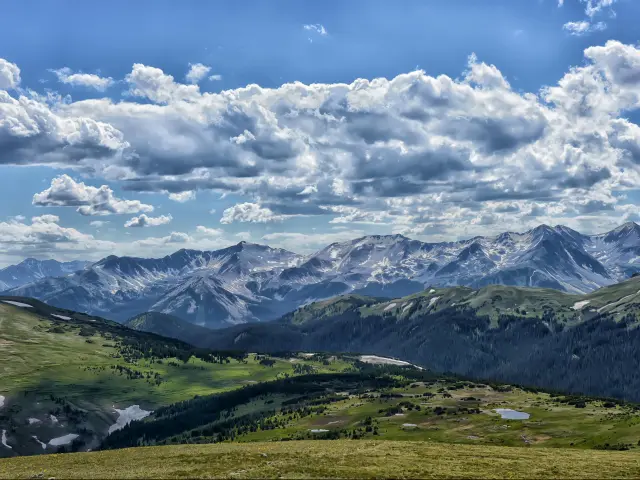
The 15-minute drive to Fern Lake Trailhead also starts at Beaver Meadows Entrance. Turn left almost immediately after the park entrance and follow Bear Lake Road until you reach Moraine Park Discovery Center.
Turn onto Moraine Park Road but before you reach the campground, turn left onto Fern Lake Road, which runs alongside Big Thompson River and passes Cub Lake Trailhead before reaching Fern Lake Trailhead at the end of the road.
The longest of our Winter Route options also starts out on Bear Lake Road, but instead of turning off, continue along Bear Lake Road past Glacier Basin and on via a couple of switchbacks to Bear Lake, where there are several trails to explore.
In a different part of the national park, further south off CO-7, follow the signs to Wild Basin. From the parking lot just after Wild Basin Lodge, you can continue to follow the road past Copeland Lake and on to Wild Basin Trailhead. Wild Basin Winter Trailhead is about halfway along the 6-mile track.
If you don't fancy driving out into the national park to experience these views and trails, snowmobile tours are also available.
How long does it take to drive through Rocky Mountain National Park?
| Road Name | Drive Time | Distance | Availability |
|---|---|---|---|
| Upper Beaver Meadows Road | 10 minutes | 2 miles | All year |
| Wild Basin Road | 10 minutes | 2 miles | All year |
| Fern Lake Road | 20 minutes | 4 miles | All year |
| Bear Lake Road | 25 minutes | 10 miles | All year |
| Trail Ridge Road | 1 hour 20 minutes | 43 miles | Summer |
Although you could spend days on end exploring the park, if you're just looking to take a scenic drive through the park you can complete the trip in just 1 hour 20 minutes.
This doesn't allow for any time you spend hiking or even just stopping to admire the unforgettable scenery, so most visitors will need to factor in more time for the route along Trail Ridge Road.
As we've already mentioned, it's not possible to drive all the way along Trail Ridge Road in the winter months, and the sections of the road which are open to vehicles are much shorter. If you're nervous about driving along the park's roads in wintery conditions then Upper Beaver Meadows Road or the Wild Basin Route are probably your best options, as both are only 2 miles long.
Which entrance should you arrive at in Rocky Mountain National Park?
Your choice of entrance will probably depend on where you start your journey to Rocky Mountain National Park.
If you're staying in the area around the national park then we'd suggest heading to either Beaver Meadows Entrance or Grand Lake Entrance to start your drive along Trail Ridge Road.
However, if you're coming from further afield, then other entrances might make for a shorter journey before you reach the national park.
Travelers come from all over the country to visit Rocky Mountain National Park, so take a look at the table below for an idea of how long it will take to get to the national park from some popular departure cities, and which entrance to aim for.
| Origin City | Entrance | Total Distance | Total Time |
|---|---|---|---|
| Denver | Beaver Meadows Entrance | 70 miles | 1 hour 30 minutes |
| Las Vegas | Grand Lake Entrance | 720 miles | 11 hours |
| Phoenix | Grand Lake Entrance | 790 miles | 12 hours 20 minutes |
| Los Angeles | Grand Lake Entrance | 980 miles | 14 hours 30 minutes |
| Chicago | Wild Basin Entrance | 1,030 miles | 15 hours |
| San Diego | Grand Lake Entrance | 1,050 miles | 15 hours 20 minutes |
| San Francisco | Grand Lake Entrance | 1,160 miles | 17 hours 40 minutes |
| Seattle | Grand Lake Entrance | 1,260 miles | 18 hours 20 minutes |
Best places to stop on a drive through Rocky Mountain National Park
While it's possible to drive right through Rocky Mountain National Park in less than half a day, many visitors opt to stay at least a night or two to allow more time to hike the trailheads and take in the amazing views.
Whether you're looking for 4-star comfort or a night under canvas, keep reading to start planning your stay in Rocky Mountain National Park.
Get a room with a view in Estes Park
If you're looking for somewhere to stay at the start of Trail Ridge Road, Estes Park is a great option. It's a picturesque mountain town 6 miles from Beaver Meadows Entrance, which is known as the gateway to Rocky Mountain National Park.

It's a great place to stay at the start of the longer Summer Route, but the town is also accessible in winter if you follow the Fern Lake Road or Bear Lake Road routes.
Take in the culture of a true mountain town by heading downtown. Enjoy a Riverwalk, dine at an independent restaurant, and browse shops and galleries, all with the backdrop of snowcapped mountains.
A short distance outside the town you'll find Woodlands on Fall River, where you'll have spectacular mountain views from the balcony of your luxury cabin. Nestled among the trees beside the river, there's also a hot tub for added relaxation after a day in the mountains.
From the hotel it's a 15-minute drive to Beaver Meadows Entrance to Rocky Mountain National Park, while downtown Estes Park is just a couple of miles away. Prospect Mountain is a 15-minute drive, and you can set out along Lake Estes Trail less than 10 minutes after departing the accommodation.
Take in the view at Grand Lake
Grand Lake is often described as the prettiest lake in Colorado, and it's the perfect place to relax after completing Trail Ridge Road.
It's also a town famed for its snowmobiling, attracting adrenaline junkies throughout winter. During the winter months you can't get here directly via the routes described above, but if you want to hit the slopes it's worth taking a detour to add Grand Lake to your itinerary.
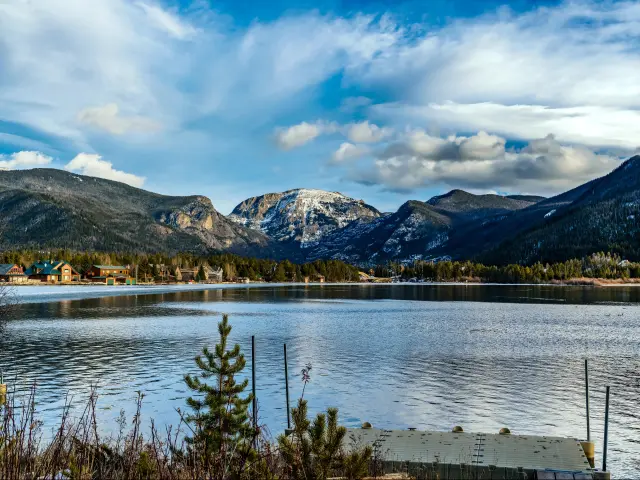
In winter, contact Grand Adventures who offer guided tours to various locations. They can take you on a snowmobile to the Continental Divide, the watershed in the mountains from where precipitation is directed either to the Pacific or Atlantic Ocean.
Even in summer there's a chance to get active in Grand Lake. Whether it's the thrill of white water rafting, or a relaxing paddleboard, there's plenty of opportunity for water-based activities here.
Back on dry land you can meander along the historic Boardwalk. Founded in 1881, it has rustic Wild West buildings and over 60 bars, restaurants, shops and galleries.
A short walk from downtown Grand Lake is the Gateway Inn, which has beautiful rustic rooms and an on-site bar and restaurant serving American food. Try to get a room with a balcony for mountain views.
It's a great place to relax, with a hot tub and sauna facilities. There's also an outdoor fireplace, and you can sit outside to enjoy the mountain air.
The hotel's ample free parking, and only a 4-minute walk to Grand Lake Visitor Center both make it a really convenient place to either end or begin your drive along Trail Ridge Road.
Where to camp in Rocky Mountain National Park
A night under canvas in Rocky Mountain National Park is one you'll never forget. There are several campgrounds to choose from, all with amazing views.
Some of the most popular campgrounds in the park are Timber Creek, Moraine Park, Glacier Basin and Aspenglen Campgrounds.
Timber Creek Campground on the Summer Route is around an hour's drive from Beaver Meadows Entrance and 20 minutes from Grand Lake. This is the only campground in the western area of Rocky Mountain National Park and enjoys a tranquil setting at the foot of the mountains.

Elk and deer are often spotted here and the Colorado River is just behind the campground so you can take a short hike to the riverside.
The campground has flush toilets and fires are allowed here. Plus, campsites have a picnic table so you can enjoy a scenic picnic looking out across the Rockies.
If you're traveling in winter head to Moraine Park Campground, one of the few campgrounds open all year round. It's a 2-mile hike to Upper Beaver Meadows Trailhead (from where it's a further 1.5 or 3.5 miles to complete the hike), or just a short 0.7-mile hike to Moraine Park.
This campground has food storage lockers all year-round to protect from bears, and firewood and ice are available seasonally.
Things you need to know about driving through Rocky Mountain National Park
While the drive through Rocky Mountain National Park is fairly straightforward, there are a few things you need to know to make sure your trip runs smoothly.
Although all entrances are open year-round, some roads, including the famous Trail Ridge Road, are closed in winter (May to October). Helpful points of information such as the Moraine Park Visitor Center and Alpine Visitor Center are closed in winter too.
During winter the roads from both Boulder and Fort Collins are plowed so access up to Beaver Meadows Entrance is good, and it's much quieter in winter months. The Wild Basin Route even has a winter trailhead.
You'll need to wrap up warm, though - January and December are the coldest months averaging 21 degrees Fahrenheit, so expect freezing conditions and significant snowfall.
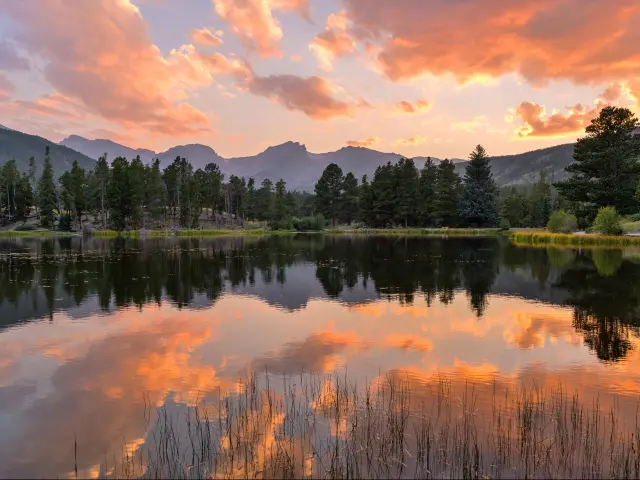
It's a legal requirement to have snow chains in Colorado. So in winter, even leading up to the Rocky Mountain National Park, have them attached. Due to altitude there can be ice in May or even early June so take care even in summer.
If you're traveling in summer, it probably won't be a surprise to hear that June to September is the busiest time in Rocky Mountain National Park. Temperatures in July and August average a little over 63 degrees Fahrenheit, so even in summer, it's a comfortable temperature for hiking.
Travelers looking to avoid both the snow and the crowds could consider visiting in spring or fall, however temperatures remain very low in March and April (still only averaging 38 degrees in April) and November sees freezing temperatures and the start of the winter snowfall.
That means late spring and early fall are probably more comfortable times to visit - late May in particular can be a good time to visit because Trail Ridge Road opens but the route is less crowded.
Whatever time of year you take your trip, an entrance fee is payable by visitors to the park. The rates are shown in the table below:
| Ticket Type | Adult Fare | Car Fare |
|---|---|---|
| Day Pass | $15 | $30 |
| Week Pass | N/A | $35 |
*Calculated at the time of writing and the car fare includes entrance fee for vehicle occupants
You can book in advance for entrance park passes, and also for campgrounds in the national park. Note that, from 26 May 2023, the national park will implement a new reservation system. Permits give visitors a two-hour period to enter the park with no designated departure time.
Here are our top tips when it comes to preparing for a drive through Rocky Mountain National Park:
- Come prepared. There are no gas stations along Trail Ridge Road so make sure you have enough gas beforehand.
- To catch a glimpse of wildlife, it's often best to drive the route before 7am. It's also less crowded.
- However, if you do get stuck in traffic, chances are it's because of wildlife on the road.
- Be wary of altitude sickness. Stay hydrated and take your time when driving.
Things to see on a drive through Rocky Mountain National Park
You'll be surrounded by the natural wonders of the Rocky Mountains when you make this trip through the national park. Here are just a few of the highlights of things to see and do.
- Trail Ridge Road - This scenic road is the highest fully-paved road in the USA. Expect to be above the alpine treetops as you snake through the Rockies on a journey full of outstanding vistas.
- Bear Lake - Not only is Bear Lake accessible all year round, but it's also one of the lowest altitude trails in the park. So it's a good place to start to get used to the elevation. Visit at sunrise to watch the sun bounce off Flat Top Mountain.
- Alberta Falls - Arguably one of the most beautiful waterfalls in the national park. To reach the falls, it's easy to hike along the creek following the Glacier Gorge Junction Trailhead.
- Camp - Even non-camping enthusiasts should give it a go. While camping may not have the modern-day luxuries, it's an experience with howling coyotes and a luminous night sky. If camping isn't your thing, then stay for nightfall so you can stargaze.
- Hike - There are ample hiking opportunities, from the easy to the more challenging. Long's Peak is the tallest and is a strenuous hike which has caused fatalities. So pick wisely and choose trails suitable for your physical health.
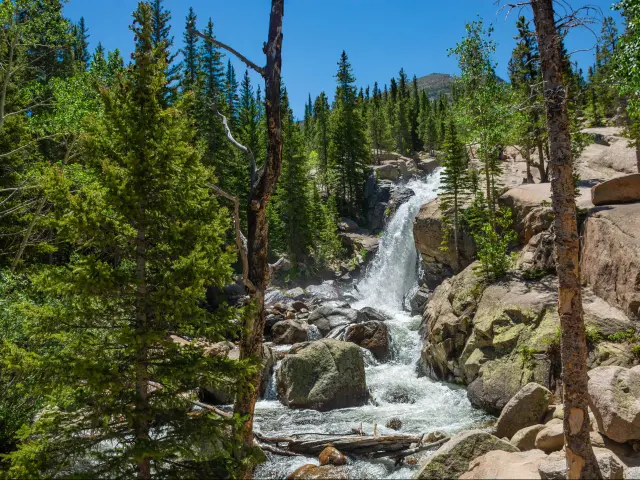
With so many miles of trails and countless stunning views to amaze you, Rocky Mountain National Park is a destination that you'll never forget, so lace up your hiking boots and hit the road for a fabulous mountain adventure.

